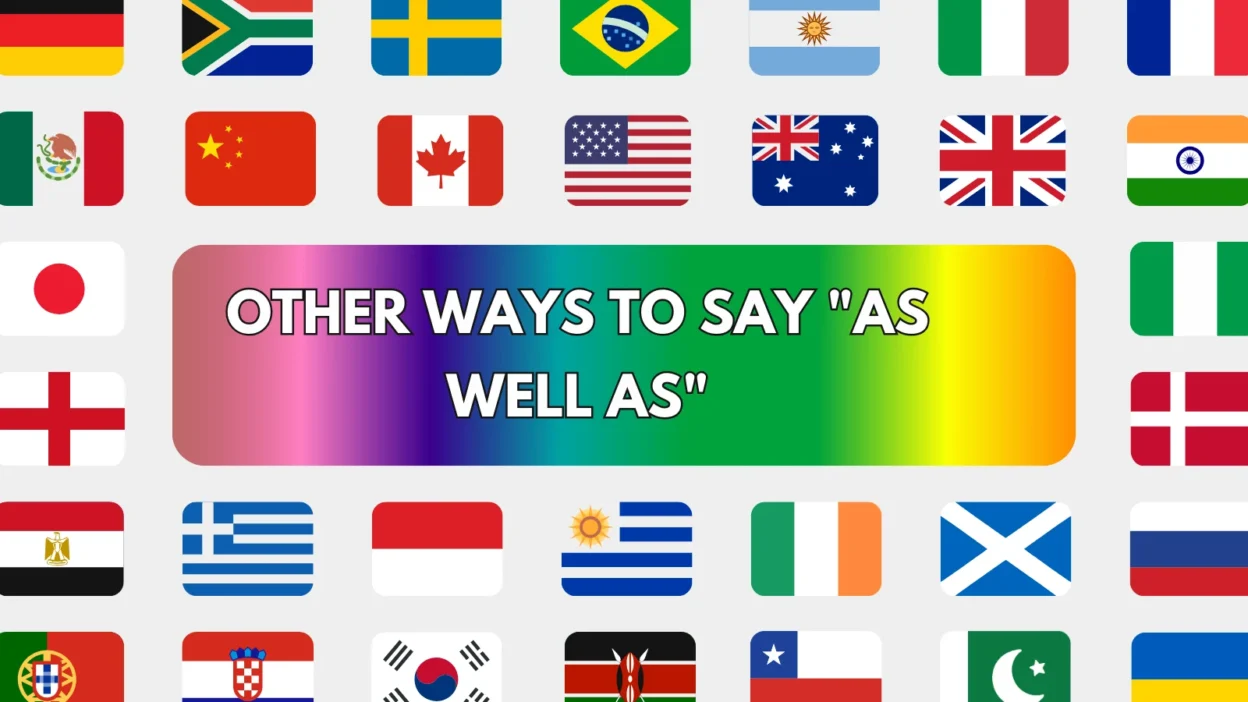The phrase “as well as” is a common and useful way to add or combine ideas in English. It’s typically used to mean “in addition to” or “along with.” However, overusing it can make your writing or speech sound repetitive or overly formal.
To improve your language fluency and keep things fresh, it helps to know alternative phrases that mean the same thing but offer variety in tone and style. This article covers 25 different ways to say “as well as”, with each alternative broken down by meaning, detailed explanation, scenario example, best use, and tone.
1. In Addition To
Meaning:
Adds one thing to another; includes more.
Detailed Explanation:
This is one of the most direct synonyms for “as well as,” commonly used in both formal and informal writing.
Scenario Example:
In addition to her studies, she works part-time at a café.
Best Use:
Essays, emails, reports, general writing.
Tone:
Neutral, clear, professional.
2. Along With
Meaning:
Means “together with” or “in company with.”
Detailed Explanation:
“Along with” suggests a physical or abstract pairing of two or more things.
Scenario Example:
He brought his resume along with a portfolio of his work.
Best Use:
Spoken English, resumes, narratives.
Tone:
Neutral, straightforward, slightly casual.
3. Together With
Meaning:
Indicates a combination or inclusion of something else.
Detailed Explanation:
Similar to “along with,” but often sounds a bit more formal or structured.
Scenario Example:
The software comes together with a user manual.
Best Use:
Instructions, business writing, formal communication.
Tone:
Polished, formal, clear.
4. Not Only… But Also
Meaning:
Shows that two positive or related things are true.
Detailed Explanation:
This construction adds emphasis and rhythm, making it ideal for persuasive writing.
Scenario Example:
She is not only intelligent but also incredibly creative.
Best Use:
Speeches, essays, formal writing.
Tone:
Emphatic, formal, impactful.
5. Moreover
Meaning:
Adds information to strengthen a point.
Detailed Explanation:
“Moreover” adds weight and formality to an argument or statement.
Scenario Example:
The service was poor; moreover, the food was cold.
Best Use:
Academic writing, reports, formal documents.
Tone:
Formal, serious, professional.
6. Also
Meaning:
Indicates that something more is being added.
Detailed Explanation:
“Also” is simple and versatile, making it great for most situations.
Scenario Example:
She also volunteers at the animal shelter.
Best Use:
Casual writing, everyday conversation.
Tone:
Neutral, friendly, simple.
7. Too
Meaning:
Means “also” or “in addition.”
Detailed Explanation:
Often used at the end of a sentence, it’s casual and common in speech.
Scenario Example:
I’d like a coffee too, please.
Best Use:
Informal speech, everyday use.
Tone:
Casual, conversational, friendly.
8. Besides
Meaning:
Adds another point, often for emphasis or reasoning.
Detailed Explanation:
“Besides” often follows a complaint or opinion and adds another layer to support it.
Scenario Example:
I can’t go. Besides, I’m not feeling well.
Best Use:
Conversational writing, blogs, informal discussions.
Tone:
Informal, opinionated, relaxed.
9. As Well
Meaning:
Another way of saying “too” or “in addition.”
Detailed Explanation:
Often used at the end of sentences, especially in British English.
Scenario Example:
She enjoys painting as well.
Best Use:
Casual writing, emails, speech.
Tone:
Neutral, gentle, conversational.
10. What’s More
Meaning:
Introduces an additional or surprising point.
Detailed Explanation:
This is often used for emphasis or when adding a powerful follow-up.
Scenario Example:
The car is fast. What’s more, it’s extremely fuel-efficient.
Best Use:
Marketing, persuasive writing, storytelling.
Tone:
Enthusiastic, persuasive, informal.
11. As Much As
Meaning:
Indicates equality or importance in addition to something else.
Detailed Explanation:
It can function like “as well as” when comparing importance.
Scenario Example:
He values kindness as much as intelligence.
Best Use:
Discussions, reflective writing, comparisons.
Tone:
Thoughtful, balanced, reflective.
12. Plus
Meaning:
Adds something additional.
Detailed Explanation:
A very casual and simple word that’s commonly used in conversation.
Scenario Example:
We’re going to the movies, plus grabbing dinner afterward.
Best Use:
Spoken English, casual emails, informal lists.
Tone:
Informal, upbeat, casual.
13. Coupled With
Meaning:
Two things are combined or linked.
Detailed Explanation:
Often used in writing to emphasize the impact of two elements together.
Scenario Example:
The heat, coupled with humidity, made it unbearable.
Best Use:
Essays, science reports, business writing.
Tone:
Formal, descriptive, analytical.
14. In the Same Way
Meaning:
Adds another element that mirrors or matches something else.
Detailed Explanation:
Used when comparing similar actions or conditions.
Scenario Example:
In the same way that she managed her finances, she also planned her time.
Best Use:
Essays, comparisons, teaching.
Tone:
Neutral, instructive, thoughtful.
15. Additionally
Meaning:
Adds extra information or support to a statement.
Detailed Explanation:
Very common in formal or academic writing to add structured points.
Scenario Example:
Additionally, we reviewed previous case studies to strengthen our approach.
Best Use:
Academic papers, business writing, formal documents.
Tone:
Professional, structured, formal.
16. Together
Meaning:
Shows inclusion and unity of two or more things.
Detailed Explanation:
Used when actions or people are joined or grouped.
Scenario Example:
Together, the students and teachers created a mural.
Best Use:
Community writing, team-based discussions.
Tone:
Inclusive, positive, cooperative.
17. With
Meaning:
Used to link two or more things occurring at the same time.
Detailed Explanation:
Simpler and more direct than “as well as,” it’s perfect for casual use.
Scenario Example:
She came with her sister to the concert.
Best Use:
Everyday speech, friendly writing.
Tone:
Simple, casual, direct.
18. Likewise
Meaning:
Means “in the same way” or “similarly.”
Detailed Explanation:
Good for mirroring ideas or actions when listing comparisons.
Scenario Example:
He studied late into the night; likewise, his brother did the same.
Best Use:
Comparisons, reflective writing.
Tone:
Neutral, thoughtful, formal.
19. Furthermore
Meaning:
Adds emphasis and detail to a previous point.
Detailed Explanation:
Often used in professional or academic writing to build an argument.
Scenario Example:
Furthermore, the data confirms our initial findings.
Best Use:
Research, formal letters, debates.
Tone:
Professional, logical, strong.
20. And
Meaning:
Connects ideas, actions, or items.
Detailed Explanation:
The most basic connector — it’s simple, flexible, and universal.
Scenario Example:
She bought apples and oranges.
Best Use:
All forms of writing and speaking.
Tone:
Neutral, versatile, clear.
21. Equally
Meaning:
Indicates two things are of equal value or importance.
Detailed Explanation:
Often used to compare or emphasize balance.
Scenario Example:
He is equally committed to his career and his family.
Best Use:
Reflective or persuasive writing.
Tone:
Balanced, fair, formal.
22. In Like Manner
Meaning:
Indicates similar behavior or condition.
Detailed Explanation:
This phrase is a bit old-fashioned, but still used in formal essays and legal documents.
Scenario Example:
The contract must be signed in like manner by both parties.
Best Use:
Legal writing, historical or formal text.
Tone:
Very formal, academic.
23. In Conjunction With
Meaning:
Used when two things work or appear together.
Detailed Explanation:
Common in technical, scientific, or legal writing.
Scenario Example:
The drug should be taken in conjunction with a balanced diet.
Best Use:
Medical, technical, or professional writing.
Tone:
Formal, scientific, clear.
24. Together As One
Meaning:
Shows unity or combined effort.
Detailed Explanation:
Often used for emotional or motivational language.
Scenario Example:
The whole community, together as one, rebuilt the town.
Best Use:
Speeches, motivational writing, community messages.
Tone:
Uplifting, emotional, collective.
25. In Tandem With
Meaning:
Means something is working simultaneously or in harmony.
Detailed Explanation:
Ideal for processes, partnerships, or systems that operate side by side.
Scenario Example:
The two departments worked in tandem to complete the project.
Best Use:
Business, technical writing, teamwork communication.
Tone:
Professional, structured, efficient.
Conclusion
The phrase “as well as” is a reliable way to connect ideas — but using a wider range of alternatives makes your writing and speech more engaging, expressive, and precise. From formal terms like “in addition to” to casual ones like “plus”, you now have 25 options to mix things up and keep your language polished.
💬



